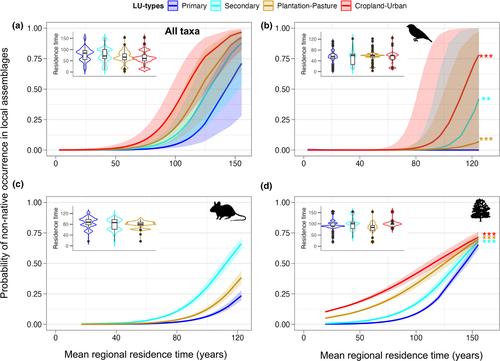当前位置:
X-MOL 学术
›
Glob. Change Biol.
›
论文详情
Our official English website, www.x-mol.net, welcomes your feedback! (Note: you will need to create a separate account there.)
Regional invasion history and land use shape the prevalence of non‐native species in local assemblages
Global Change Biology ( IF 10.8 ) Pub Date : 2024-07-25 , DOI: 10.1111/gcb.17426 Daijun Liu 1 , Franz Essl 1 , Bernd Lenzner 1 , Dietmar Moser 1 , Philipp Semenchuk 1, 2, 3 , Tim M. Blackburn 4, 5 , Phillip Cassey 6 , Dino Biancolini 7, 8, 9 , César Capinha 10, 11 , Wayne Dawson 12 , Ellie E. Dyer 4, 13 , Benoit Guénard 14 , Evan P. Economo 15 , Holger Kreft 16, 17, 18 , Jan Pergl 19 , Petr Pyšek 19, 20 , Mark van Kleunen 21, 22 , Carlo Rondinini 8 , Hanno Seebens 23 , Patrick Weigelt 16, 17, 18 , Marten Winter 24 , Andy Purvis 25, 26 , Stefan Dullinger 1
Global Change Biology ( IF 10.8 ) Pub Date : 2024-07-25 , DOI: 10.1111/gcb.17426 Daijun Liu 1 , Franz Essl 1 , Bernd Lenzner 1 , Dietmar Moser 1 , Philipp Semenchuk 1, 2, 3 , Tim M. Blackburn 4, 5 , Phillip Cassey 6 , Dino Biancolini 7, 8, 9 , César Capinha 10, 11 , Wayne Dawson 12 , Ellie E. Dyer 4, 13 , Benoit Guénard 14 , Evan P. Economo 15 , Holger Kreft 16, 17, 18 , Jan Pergl 19 , Petr Pyšek 19, 20 , Mark van Kleunen 21, 22 , Carlo Rondinini 8 , Hanno Seebens 23 , Patrick Weigelt 16, 17, 18 , Marten Winter 24 , Andy Purvis 25, 26 , Stefan Dullinger 1
Affiliation

|
The ecological impact of non‐native species arises from their establishment in local assemblages. However, the rates of non‐native spread in new regions and their determinants have not been comprehensively studied. Here, we combined global databases documenting the occurrence of non‐native species and residence of non‐native birds, mammals, and vascular plants at regional and local scales to describe how the likelihood of non‐native occurrence and their proportion in local assemblages relate with their residence time and levels of human usage in different ecosystems. Our findings reveal that local non‐native occurrence generally increases with residence time. Colonization is most rapid in croplands and urban areas, while it is slower and variable in natural or semi‐natural ecosystems. Notably, non‐native occurrence continues to rise even 200 years after introduction, especially for birds and vascular plants, and in other land‐use types rather than croplands and urban areas. The impact of residence time on non‐native proportions is significant only for mammals. We conclude that the continental exchange of biotas requires considerable time for effects to manifest at the local scale across taxa and land‐use types. The unpredictability of future impacts, implied by the slow spread of non‐native species, strengthens the call for stronger regulations on the exchange of non‐native species to reduce the long‐lasting invasion debt looming on ecosystems' future.
中文翻译:

区域入侵历史和土地利用影响了当地组合中非本地物种的流行
非本地物种的生态影响源于它们在当地组合中的建立。然而,新地区的非本地传播率及其决定因素尚未得到全面研究。在这里,我们结合了记录非本地物种的出现以及非本地鸟类、哺乳动物和维管植物在区域和地方尺度上的居住情况的全球数据库,以描述非本地出现的可能性及其在本地组合中的比例如何与它们在不同生态系统中的停留时间和人类使用水平。我们的研究结果表明,当地非本地发生率通常随着居住时间的延长而增加。农田和城市地区的殖民化速度最快,而自然或半自然生态系统的殖民化速度较慢且多变。值得注意的是,即使在引入后 200 年,非本地物种的发生率仍在继续上升,特别是对于鸟类和维管束植物,以及其他土地利用类型(而不是农田和城市地区)。停留时间对非本地动物比例的影响仅对哺乳动物而言显着。我们的结论是,大陆生物区系交换需要相当长的时间才能在局部范围内对类群和土地利用类型产生影响。非本地物种的缓慢扩散所暗示的未来影响的不可预测性,更加强烈地呼吁对非本地物种的交换进行更严格的监管,以减少生态系统未来面临的长期入侵债务。
更新日期:2024-07-25
中文翻译:

区域入侵历史和土地利用影响了当地组合中非本地物种的流行
非本地物种的生态影响源于它们在当地组合中的建立。然而,新地区的非本地传播率及其决定因素尚未得到全面研究。在这里,我们结合了记录非本地物种的出现以及非本地鸟类、哺乳动物和维管植物在区域和地方尺度上的居住情况的全球数据库,以描述非本地出现的可能性及其在本地组合中的比例如何与它们在不同生态系统中的停留时间和人类使用水平。我们的研究结果表明,当地非本地发生率通常随着居住时间的延长而增加。农田和城市地区的殖民化速度最快,而自然或半自然生态系统的殖民化速度较慢且多变。值得注意的是,即使在引入后 200 年,非本地物种的发生率仍在继续上升,特别是对于鸟类和维管束植物,以及其他土地利用类型(而不是农田和城市地区)。停留时间对非本地动物比例的影响仅对哺乳动物而言显着。我们的结论是,大陆生物区系交换需要相当长的时间才能在局部范围内对类群和土地利用类型产生影响。非本地物种的缓慢扩散所暗示的未来影响的不可预测性,更加强烈地呼吁对非本地物种的交换进行更严格的监管,以减少生态系统未来面临的长期入侵债务。













































 京公网安备 11010802027423号
京公网安备 11010802027423号